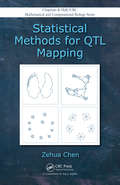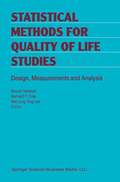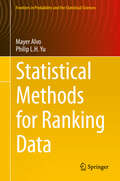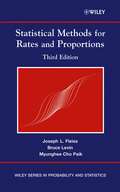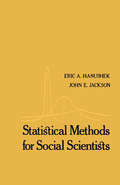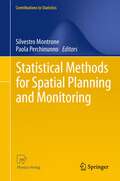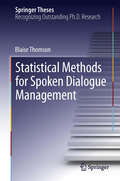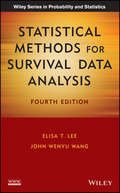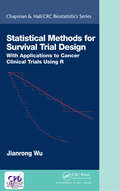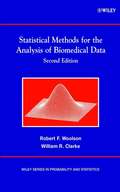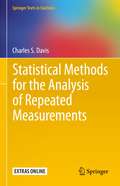- Table View
- List View
Statistical Methods for QTL Mapping (Chapman & Hall/CRC Computational Biology Series)
by Zehua ChenWhile numerous advanced statistical approaches have recently been developed for quantitative trait loci (QTL) mapping, the methods are scattered throughout the literature. Statistical Methods for QTL Mapping brings together many recent statistical techniques that address the data complexity of QTL mapping. After introducing basic genetics topics an
Statistical Methods for Quality Assurance: Basics, Measurement, Control, Capability, and Improvement (Springer Texts in Statistics)
by Stephen B. Vardeman J. Marcus JobeThis undergraduate statistical quality assurance textbook clearly shows with real projects, cases and data sets how statistical quality control tools are used in practice. Among the topics covered is a practical evaluation of measurement effectiveness for both continuous and discrete data. Gauge Reproducibility and Repeatability methodology (including confidence intervals for Repeatability, Reproducibility and the Gauge Capability Ratio) is thoroughly developed. Process capability indices and corresponding confidence intervals are also explained. In addition to process monitoring techniques, experimental design and analysis for process improvement are carefully presented. Factorial and Fractional Factorial arrangements of treatments and Response Surface methods are covered.Integrated throughout the book are rich sets of examples and problems that help readers gain a better understanding of where and how to apply statistical quality control tools. These large and realistic problem sets in combination with the streamlined approach of the text and extensive supporting material facilitate reader understanding.Second Edition ImprovementsExtensive coverage of measurement quality evaluation (in addition to ANOVA Gauge R&R methodologies)New end-of-section exercises and revised-end-of-chapter exercisesTwo full sets of slides, one with audio to assist student preparation outside-of-class and another appropriate for professors’ lecturesSubstantial supporting materialSupporting MaterialSeven R programs that support variables and attributes control chart construction and analyses, Gauge R&R methods, analyses of Fractional Factorial studies, Propagation of Error analyses and Response Surface analysesDocumentation for the R programsExcel data files associated with the end-of-chapter problem sets, most from real engineering settings
Statistical Methods for Quality of Life Studies: Design, Measurements and Analysis
by Mounir Mesbah Bernard F. Cole Mei-Ling Ting Mei-Ling Ting LeeOn October 16 and 17, 2000, we hosted an international workshop entitled "Statistical Design, Measurement, and Analysis of Health Related Quality of Life." The workshop was held in the beautiful city of Arradon, South Brittany, France with the main goal of fostering an interdisciplinary forum for discussion of theoretical and applied statistical issues arising in studies of health-related quality of life (HRQoL). Included were biostatisticians, psychometricians and public health professionals (e.g., physicians, sociologists, psychologists) active in the study ofHRQoL. In assembling this volume, we invited each conference participant to contribute a paper based on his or her presentation and the ensuing and very interesting discussions that took place in Arradon. All papers were peer-reviewed, by anonymous reviewers, and revised before final editing and acceptance. Although this process was quite time consuming, we believe that it greatly improved the volume as a whole, making this book a valuable contribution to the field ofHRQoL research. The volume presents a broad spectrum of papers presented at the Workshop, and thus illustrates the range of current research related to the theory, methods and applications of HRQoL, as well as the interdisciplinary nature ofthis work. Following an introduction written by Sir David Cox, it includes 27 articles organized into the following chapters.
Statistical Methods for Ranking Data (Frontiers in Probability and the Statistical Sciences)
by Mayer Alvo Philip L.H. YuThis book introduces advanced undergraduate, graduate students and practitioners to statistical methods for ranking data. An important aspect of nonparametric statistics is oriented towards the use of ranking data. Rank correlation is defined through the notion of distance functions and the notion of compatibility is introduced to deal with incomplete data. Ranking data are also modeled using a variety of modern tools such as CART, MCMC, EM algorithm and factor analysis.This book deals with statistical methods used for analyzing such data and provides a novel and unifying approach for hypotheses testing. The techniques described in the book are illustrated with examples and the statistical software is provided on the authors’ website.
Statistical Methods for Rates and Proportions (Wiley Series in Probability and Statistics #477)
by Joseph L. Fleiss Bruce Levin Myunghee Cho Paik* Includes a new chapter on logistic regression. * Discusses the design and analysis of random trials. * Explores the latest applications of sample size tables. * Contains a new section on binomial distribution.
Statistical Methods for Rates and Proportions (Wiley Series in Probability and Statistics #477)
by Joseph L. Fleiss Bruce Levin Myunghee Cho Paik* Includes a new chapter on logistic regression. * Discusses the design and analysis of random trials. * Explores the latest applications of sample size tables. * Contains a new section on binomial distribution.
Statistical Methods for Reliability Data (Wiley Series in Probability and Statistics #314)
by William Q. Meeker Luis A. EscobarAmstat News asked three review editors to rate their top five favorite books in the September 2003 issue. Statistical Methods for Reliability Data was among those chosen. Bringing statistical methods for reliability testing in line with the computer age This volume presents state-of-the-art, computer-based statistical methods for reliability data analysis and test planning for industrial products. Statistical Methods for Reliability Data updates and improves established techniques as it demonstrates how to apply the new graphical, numerical, or simulation-based methods to a broad range of models encountered in reliability data analysis. It includes methods for planning reliability studies and analyzing degradation data, simulation methods used to complement large-sample asymptotic theory, general likelihood-based methods of handling arbitrarily censored data and truncated data, and more. In this book, engineers and statisticians in industry and academia will find: A wealth of information and procedures developed to give products a competitive edge Simple examples of data analysis computed with the S-PLUS system-for which a suite of functions and commands is available over the Internet End-of-chapter, real-data exercise sets Hundreds of computer graphics illustrating data, results of analyses, and technical concepts An essential resource for practitioners involved in product reliability and design decisions, Statistical Methods for Reliability Data is also an excellent textbook for on-the-job training courses, and for university courses on applied reliability data analysis at the graduate level. An Instructor's Manual presenting detailed solutions to all the problems in the book is available upon requestfrom the Wiley editorial department.
Statistical Methods for Reliability Data (Wiley Series in Probability and Statistics #314)
by William Q. Meeker Luis A. EscobarAmstat News asked three review editors to rate their top five favorite books in the September 2003 issue. Statistical Methods for Reliability Data was among those chosen. Bringing statistical methods for reliability testing in line with the computer age This volume presents state-of-the-art, computer-based statistical methods for reliability data analysis and test planning for industrial products. Statistical Methods for Reliability Data updates and improves established techniques as it demonstrates how to apply the new graphical, numerical, or simulation-based methods to a broad range of models encountered in reliability data analysis. It includes methods for planning reliability studies and analyzing degradation data, simulation methods used to complement large-sample asymptotic theory, general likelihood-based methods of handling arbitrarily censored data and truncated data, and more. In this book, engineers and statisticians in industry and academia will find: A wealth of information and procedures developed to give products a competitive edge Simple examples of data analysis computed with the S-PLUS system-for which a suite of functions and commands is available over the Internet End-of-chapter, real-data exercise sets Hundreds of computer graphics illustrating data, results of analyses, and technical concepts An essential resource for practitioners involved in product reliability and design decisions, Statistical Methods for Reliability Data is also an excellent textbook for on-the-job training courses, and for university courses on applied reliability data analysis at the graduate level. An Instructor's Manual presenting detailed solutions to all the problems in the book is available upon requestfrom the Wiley editorial department.
Statistical Methods for Social Scientists
by Eric A Hanushek John E. JacksonThe aspects of this text which we believe are novel, at least in degree, include: an effort to motivate different sections with practical examples and an empirical orientation; an effort to intersperse several easily motivated examples throughout the book and to maintain some continuity in these examples; and the extensive use of Monte Carlo simulations to demonstrate particular aspects of the problems and estimators being considered. In terms of material being presented, the unique aspects include the first chapter which attempts to address the use of empirical methods in the social sciences, the seventh chapter which considers models with discrete dependent variables and unobserved variables. Clearly these last two topics in particular are quite advanced--more advanced than material that is currently available on the subject. These last two topics are also currently experiencing rapid development and are not adequately described in most other texts.
Statistical Methods for Spatial Data Analysis (Chapman & Hall/CRC Texts in Statistical Science)
by Carol A. Gotway Oliver SchabenbergerUnderstanding spatial statistics requires tools from applied and mathematical statistics, linear model theory, regression, time series, and stochastic processes. It also requires a mindset that focuses on the unique characteristics of spatial data and the development of specialized analytical tools designed explicitly for spatial data analysis. Statistical Methods for Spatial Data Analysis answers the demand for a text that incorporates all of these factors by presenting a balanced exposition that explores both the theoretical foundations of the field of spatial statistics as well as practical methods for the analysis of spatial data. This book is a comprehensive and illustrative treatment of basic statistical theory and methods for spatial data analysis, employing a model-based and frequentist approach that emphasizes the spatial domain. It introduces essential tools and approaches including: measures of autocorrelation and their role in data analysis; the background and theoretical framework supporting random fields; the analysis of mapped spatial point patterns; estimation and modeling of the covariance function and semivariogram; a comprehensive treatment of spatial analysis in the spectral domain; and spatial prediction and kriging. The volume also delivers a thorough analysis of spatial regression, providing a detailed development of linear models with uncorrelated errors, linear models with spatially-correlated errors and generalized linear mixed models for spatial data. It succinctly discusses Bayesian hierarchical models and concludes with reviews on simulating random fields, non-stationary covariance, and spatio-temporal processes.Additional material on the CRC Press website supplements the content of this book. The site provides data sets used as examples in the text, software code that can be used to implement many of the principal methods described and illustrated, and updates to the text itself.
Statistical Methods for Spatial Data Analysis (Chapman & Hall/CRC Texts in Statistical Science)
by Oliver Schabenberger Carol A. GotwayUnderstanding spatial statistics requires tools from applied and mathematical statistics, linear model theory, regression, time series, and stochastic processes. It also requires a mindset that focuses on the unique characteristics of spatial data and the development of specialized analytical tools designed explicitly for spatial data analysis. Statistical Methods for Spatial Data Analysis answers the demand for a text that incorporates all of these factors by presenting a balanced exposition that explores both the theoretical foundations of the field of spatial statistics as well as practical methods for the analysis of spatial data. This book is a comprehensive and illustrative treatment of basic statistical theory and methods for spatial data analysis, employing a model-based and frequentist approach that emphasizes the spatial domain. It introduces essential tools and approaches including: measures of autocorrelation and their role in data analysis; the background and theoretical framework supporting random fields; the analysis of mapped spatial point patterns; estimation and modeling of the covariance function and semivariogram; a comprehensive treatment of spatial analysis in the spectral domain; and spatial prediction and kriging. The volume also delivers a thorough analysis of spatial regression, providing a detailed development of linear models with uncorrelated errors, linear models with spatially-correlated errors and generalized linear mixed models for spatial data. It succinctly discusses Bayesian hierarchical models and concludes with reviews on simulating random fields, non-stationary covariance, and spatio-temporal processes.Additional material on the CRC Press website supplements the content of this book. The site provides data sets used as examples in the text, software code that can be used to implement many of the principal methods described and illustrated, and updates to the text itself.
Statistical Methods for Spatial Planning and Monitoring (Contributions to Statistics)
by Silvestro Montrone and Paola PerchinunnoThe book aims to investigate methods and techniques for spatial statistical analysis suitable to model spatial information in support of decision systems. Over the last few years there has been a considerable interest in these tools and in the role they can play in spatial planning and environmental modelling.One of the earliest and most famous definition of spatial planning was “a geographical expression to the economic, social, cultural and ecological policies of society”: borrowing from this point of view, this text shows how an interdisciplinary approach is an effective way to an harmonious integration of national policies with regional and local analysis.A wide range of spatial models and techniques is, also, covered: spatial data mining, point processes analysis, nearest neighbor statistics and cluster detection, Fuzzy Regression model and local indicators of spatial association; all of these tools provide the policy-maker with a valuable support to policy development.
Statistical Methods for Spoken Dialogue Management (Springer Theses)
by Blaise ThomsonSpeech is the most natural mode of communication and yet attempts to build systems which support robust habitable conversations between a human and a machine have so far had only limited success. A key reason is that current systems treat speech input as equivalent to a keyboard or mouse, and behaviour is controlled by predefined scripts that try to anticipate what the user will say and act accordingly. But speech recognisers make many errors and humans are not predictable; the result is systems which are difficult to design and fragile in use.Statistical methods for spoken dialogue management takes a radically different view. It treats dialogue as the problem of inferring a user's intentions based on what is said. The dialogue is modelled as a probabilistic network and the input speech acts are observations that provide evidence for performing Bayesian inference. The result is a system which is much more robust to speech recognition errors and for which a dialogue strategy can be learned automatically using reinforcement learning. The thesis describes both the architecture, the algorithms needed for fast real-time inference over very large networks, model parameter estimation and policy optimisation. This ground-breaking work will be of interest both to practitioners in spoken dialogue systems and to cognitive scientists interested in models of human behaviour.
Statistical Methods for Survival Data Analysis (Wiley Series in Probability and Statistics #Vol. 281)
by Elisa T. Lee John Wenyu WangPraise for the Third Edition “. . . an easy-to read introduction to survival analysis which covers the major concepts and techniques of the subject.” —Statistics in Medical Research Updated and expanded to reflect the latest developments, Statistical Methods for Survival Data Analysis, Fourth Edition continues to deliver a comprehensive introduction to the most commonly-used methods for analyzing survival data. Authored by a uniquely well-qualified author team, the Fourth Edition is a critically acclaimed guide to statistical methods with applications in clinical trials, epidemiology, areas of business, and the social sciences. The book features many real-world examples to illustrate applications within these various fields, although special consideration is given to the study of survival data in biomedical sciences. Emphasizing the latest research and providing the most up-to-date information regarding software applications in the field, Statistical Methods for Survival Data Analysis, Fourth Edition also includes: Marginal and random effect models for analyzing correlated censored or uncensored data Multiple types of two-sample and K-sample comparison analysis Updated treatment of parametric methods for regression model fitting with a new focus on accelerated failure time models Expanded coverage of the Cox proportional hazards model Exercises at the end of each chapter to deepen knowledge of the presented material Statistical Methods for Survival Data Analysis is an ideal text for upper-undergraduate and graduate-level courses on survival data analysis. The book is also an excellent resource for biomedical investigators, statisticians, and epidemiologists, as well as researchers in every field in which the analysis of survival data plays a role.
Statistical Methods for Survival Data Analysis (Wiley Series in Probability and Statistics)
by Elisa T. Lee John Wenyu WangPraise for the Third Edition “. . . an easy-to read introduction to survival analysis which covers the major concepts and techniques of the subject.” —Statistics in Medical Research Updated and expanded to reflect the latest developments, Statistical Methods for Survival Data Analysis, Fourth Edition continues to deliver a comprehensive introduction to the most commonly-used methods for analyzing survival data. Authored by a uniquely well-qualified author team, the Fourth Edition is a critically acclaimed guide to statistical methods with applications in clinical trials, epidemiology, areas of business, and the social sciences. The book features many real-world examples to illustrate applications within these various fields, although special consideration is given to the study of survival data in biomedical sciences. Emphasizing the latest research and providing the most up-to-date information regarding software applications in the field, Statistical Methods for Survival Data Analysis, Fourth Edition also includes: Marginal and random effect models for analyzing correlated censored or uncensored data Multiple types of two-sample and K-sample comparison analysis Updated treatment of parametric methods for regression model fitting with a new focus on accelerated failure time models Expanded coverage of the Cox proportional hazards model Exercises at the end of each chapter to deepen knowledge of the presented material Statistical Methods for Survival Data Analysis is an ideal text for upper-undergraduate and graduate-level courses on survival data analysis. The book is also an excellent resource for biomedical investigators, statisticians, and epidemiologists, as well as researchers in every field in which the analysis of survival data plays a role.
Statistical Methods for Survival Trial Design: With Applications to Cancer Clinical Trials Using R (Chapman & Hall/CRC Biostatistics Series)
by Jianrong WuStatistical Methods for Survival Trial Design: With Applications to Cancer Clinical Trials Using R provides a thorough presentation of the principles of designing and monitoring cancer clinical trials in which time-to-event is the primary endpoint. Traditional cancer trial designs with time-to-event endpoints are often limited to the exponential model or proportional hazards model. In practice, however, those model assumptions may not be satisfied for long-term survival trials. This book is the first to cover comprehensively the many newly developed methodologies for survival trial design, including trial design under the Weibull survival models; extensions of the sample size calculations under the proportional hazard models; and trial design under mixture cure models, complex survival models, Cox regression models, and competing-risk models. A general sequential procedure based on the sequential conditional probability ratio test is also implemented for survival trial monitoring. All methodologies are presented with sufficient detail for interested researchers or graduate students.
Statistical Methods for Survival Trial Design: With Applications to Cancer Clinical Trials Using R (Chapman & Hall/CRC Biostatistics Series)
by Jianrong WuStatistical Methods for Survival Trial Design: With Applications to Cancer Clinical Trials Using R provides a thorough presentation of the principles of designing and monitoring cancer clinical trials in which time-to-event is the primary endpoint. Traditional cancer trial designs with time-to-event endpoints are often limited to the exponential model or proportional hazards model. In practice, however, those model assumptions may not be satisfied for long-term survival trials. This book is the first to cover comprehensively the many newly developed methodologies for survival trial design, including trial design under the Weibull survival models; extensions of the sample size calculations under the proportional hazard models; and trial design under mixture cure models, complex survival models, Cox regression models, and competing-risk models. A general sequential procedure based on the sequential conditional probability ratio test is also implemented for survival trial monitoring. All methodologies are presented with sufficient detail for interested researchers or graduate students.
Statistical Methods for the Analysis of Biomedical Data (Wiley Series in Probability and Statistics #371)
by Robert F. Woolson William R. ClarkeThe new edition adds a chapter on multiple linear regression in biomedical research, with sections including the multiple linear regressions model and least squares; the ANOVA table, parameter estimates, and confidence intervals; partial f-tests; polynomial regression; and analysis of covariance. * Organized by problem rather than method, so it guides readers to the correct technique for solving the problem at hand.
Statistical Methods for the Analysis of Repeated Measurements (Springer Texts in Statistics)
by Charles S. DavisA comprehensive introduction to a wide variety of statistical methods for the analysis of repeated measurements. It is designed to be both a useful reference for practitioners and a textbook for a graduate-level course focused on methods for the analysis of repeated measurements. The important features of this book include a comprehensive coverage of classical and recent methods for continuous and categorical outcome variables; numerous homework problems at the end of each chapter; and the extensive use of real data sets in examples and homework problems.
Statistical Methods for the Assessment of Point Source Pollution: Proceedings of a Workshop on Statistical Methods for the Assessment of Point Source Pollution, held in Burlington, Ontario, Canada
by D. T. Chapman A. H. El-ShaarawiThis book contains the proceedings of a workshop, 'Statistical Methods for the Assess ment of Point Source Pollution', held September 12-14, 1988, at the Canada Centre for Inland Waters in Burlington, Ontario, Canada. The objectives of the workshop were to: a) advance the art, science, and application of statistical methods to current water quality issues by stimulating discussions and disseminating ideas and information. The emphasis was on statistical problems associated with monitor ing and controlling discharges from industries and municipalities and assessing the impact of these discharges on receiving water quality, b) provide a forum for managers, engineers, scientists, and statisticians to present and discuss techniques for evaluating water quality data and planning monitoring activities, c) provide a published state-of-the art summary of the application of statistical methods for the assessment of point source discharges and their impact on water qUality. The papers contained in this volume cover a number of topics that are of concern not only for monitoring and assessing point source pollution but also for other environmental problems.
Statistical Methods for the Evaluation of Educational Services and Quality of Products (Contributions to Statistics)
by Paola Monari Matilde Bini Domenico Piccolo Luigi SalmasoThe book presents statistical methods and models that can usefully support the ev- uation of educational services and quality of products. The contributions collected in this book summarize the work of several researchers from the universities of Bologna, Firenze, Napoli and Padova. The contributions are written with a cons- tent notation and a uni?ed view, and concern methodological advances developed mostly with reference to speci?c problems of evaluation using real data sets. The evaluation of educational services, as well as the analysis of judgements and preferences, poses severe methodological challenges because of the presence of one or more of the following aspects: the observational (non experimental) nature of the context, which is associated with the well-known problems of selection bias and presence of nuisance factors; the hierarchical structure of the data, that entails c- related observations and consideration of effects at different levels of the hierarchy and their interactions (multilevel analysis); the multivariate and qualitative nature of the dependent variable, that requires the use of ad hoc statistical methodologies; the presence of non observable factors, e. g. the satisfaction, calling for the use of latent variables models; the simultaneous presence of components of pleasure and components of uncertainty in the explication of the judgments, that asks for the speci?cation and estimation of mixture models. The ?rst part of the book deals with latent variable models.
Statistical Methods for the Evaluation of University Systems (Contributions to Statistics)
by Massimo Attanasio and Vincenza CapursiThis book presents a collection of statistical methods and procedures to assess data coming from educational systems. The topics examined include: statistical methods for constructing composite indicators, applied measurements, assessment of educational systems, measurement of the performance of the students at Italian universities, and statistical modeling for questionnaire data. Other issues are the implications of introducing different assessment criteria and procedures to the Italian university system.
Statistical Methods for the Social and Behavioural Sciences: A Model-Based Approach
by David B. FloraStatistical methods in modern research increasingly entail developing, estimating and testing models for data. Rather than rigid methods of data analysis, the need today is for more flexible methods for modelling data. In this logical, easy-to-follow and exceptionally clear book, David Flora provides a comprehensive survey of the major statistical procedures currently used. His innovative model-based approach teaches you how to: Understand and choose the right statistical model to fit your data Match substantive theory and statistical models Apply statistical procedures hands-on, with example data analyses Develop and use graphs to understand data and fit models to data Work with statistical modeling principles using any software package Learn by applying, with input and output files for R, SAS, SPSS, and Mplus. Statistical Methods for the Social and Behavioural Sciences: A Model Based Approach is the essential guide for those looking to extend their understanding of the principles of statistics, and begin using the right statistical modeling method for their own data. It is particularly suited to second or advanced courses in statistical methods across the social and behavioural sciences.
Statistical Methods for the Social and Behavioural Sciences: A Model-Based Approach
by David B. FloraStatistical methods in modern research increasingly entail developing, estimating and testing models for data. Rather than rigid methods of data analysis, the need today is for more flexible methods for modelling data. In this logical, easy-to-follow and exceptionally clear book, David Flora provides a comprehensive survey of the major statistical procedures currently used. His innovative model-based approach teaches you how to: Understand and choose the right statistical model to fit your data Match substantive theory and statistical models Apply statistical procedures hands-on, with example data analyses Develop and use graphs to understand data and fit models to data Work with statistical modeling principles using any software package Learn by applying, with input and output files for R, SAS, SPSS, and Mplus. Statistical Methods for the Social and Behavioural Sciences: A Model Based Approach is the essential guide for those looking to extend their understanding of the principles of statistics, and begin using the right statistical modeling method for their own data. It is particularly suited to second or advanced courses in statistical methods across the social and behavioural sciences.
